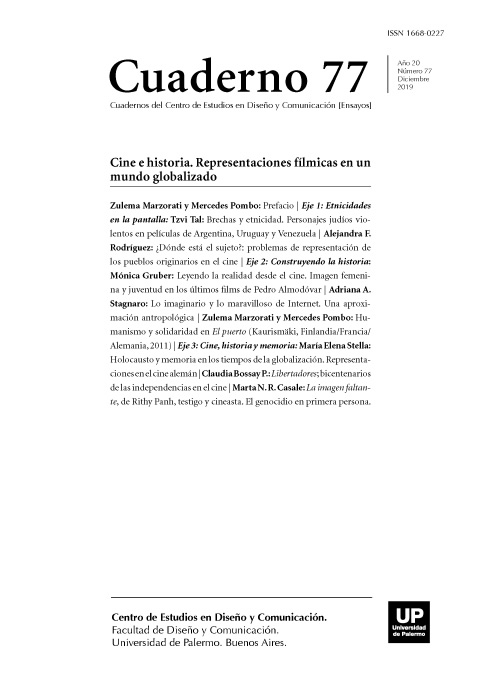La imagen faltante, de Rithy Panh, testigo y cineasta. El genocidio en primera persona
Abstract
For more than a decade the Cambodian director has been addressing the issue of genocide in his country during the Democratic Kampuchea (1975-1979) in different documentary films, always with the intention of recording the atrocities of the regime. In all the works before The missing picture (2013), the film in which we will focus on this paper, this approach is made by taking distance from the events described, events in which, however, Rithy Panh was directly involved, considering that he and his family were prisoners in forced-labor camps, being him the only survivor.
As happen with all the films that attempt to document genocide, Panh brings back to the fore the issue of the possibility or impossibility (ethics, material, psychological) of accounting for a phenomenon that destroys human dignity and carries the cruelty to extreme limits. Is it lawful to turn a massacre into a “spectacle”? Is it inevitable to do it when you want to represent it? What happens when the testimony is in the first person? Is subjectivity an obstacle? The Cambodian director chooses to use clay figures instead of people in his film to replace –in the existing images of what happened– what they lack: torture, exploitation, murders. It is the story of a child (he was 13 years old when he was ripped out of his house and his memories are those that stitch together the story), but also the story of a filmmaker and, because of this duality, the reflection on the image have, in addition to theoretical depth, a simplicity that makes it, at the same time, more brutal and more poetic. It is questioning (what happened, but also, how to represent it or represent himself), but above all, it is testimony: it replace what was left out of the picture, covered up, hidden behind the revolutionary fanfare
References
Amado, A. (2009). La imagen justa: cine argentino y política (1980-2007). Buenos Aires: Colihue.
Aprea, G. (2015). Documental, testimonios y memorias: miradas sobre el pasado militante. Buenos Aires: Manantial.
Aprea, G. (2010). “Dos momentos en el uso de los testimonios en autores de documentales latinoamericanos” en Revista Cine Documental, Buenos Aires, N° 1 Año 1.
Aprea, G. (2008). “Testimonios: Oralidad y visibilidad en los documentales argentinos contemporáneos”. Ponencia presentada en las V Jornadas de Sociología de la UNLP. Facultad de Humanidades y Ciencias de la Educación.
Campos, J. (2016). Posmilitante. Un análisis del. Revista Alter/nativas N° 6.
Casale, M. N. R. (2017). “El testimonio de los verdugos en el cine sobre genocidios. La confrontación como procedimiento ético y estético”. Ponencia presentada en las XVI Jornadas Interescuelas, del 9 al 11 de Agosto de 2017, Mar del Plata, Buenos Aires, Argentina.
Casale, M. N. R. (2015). “Mutaciones en los discursos cinematográficos sobre las víctimas de la dictadura” en Revista Afuera Estudios de Crítica Cultural - Año X- N° 15.
Casale, M. N. R. (2011). “El cine en la postdictadura: los documentales histórico-políticos durante el primer gobierno democrático”. En Una historia del cine político y social en Argentina: formas, estilos y registros. Vol II, Lusnich, Ana Laura y Pablo Piedras (Editores), Buenos Aires: Nueva Librería.
Dawidiuk, C. L. (2012). “Las representaciones cinematográficas de los campos de concentración nazi Décadas de 1940 a 1950”. Ponencia presentada en VII Jornadas de Sociología de la Universidad Nacional de La Plata “Argentina en el escenario latinoamericano actual: debates desde las ciencias sociales”.
Feld, C. (2002). Del Estrado a la pantalla: las imágenes del juicio a los ex comandantes en Argentina. Madrid: Siglo XXI.
Ferro, M. (2008). El cine una visión de la historia. Madrid: Akal.
Jelin, E. (2001). Los trabajos de la memoria. Madrid: Sigo XXI de España.
Lindeperg, S. (2016). Noche y niebla: un film en la historia. Buenos Aires: Prometeo Libros (1ª ed.).
Didi-Huberman, G. (2004). Imágenes pese a todo. Memoria visual del Holocausto. Barcelona: Paidós.
Jelin, E. (2001). Los trabajos de la memoria. Madrid: Sigo XXI de España.
LaCapra, D. (2009). Historia y memoria después de Auschwitz. Buenos Aires: Prometeo Libros.
Nancy, J.-L. (2006). La representación prohibida. Seguido de La Shoah, un soplo. Buenos aires-Madrid: Amorrortu editores.
Nichols, B. (1997). La representación de la realidad. Cuestiones y conceptos sobre el documental. Buenos Aires: Paidós.
Piedras, P. (2014). El cine documental en primera persona. Buenos Aires: Paidós.
Plantinga, C. R. (1997). Rhetoric and Representation in Nonfiction Film. New York: Cambridge University Press.
Pollak, M. (2006). Memoria, olvido, silencio. La producción social de identidades frente a situaciones límite. La Plata: Ediciones Al Margen.
Raggio, S. (2009). “La noche de los lápices: del testimonio judicial al relato cinematográfico” en Feld, Claudia y Jessica Stites Mor (2009). El pasado que miramos: memoria e imagen ante la historia reciente. Buenos Aires: Paidós.
Rivette, J. (1961). “De la abyección” en Cahiers du Cinéma nº 120, junio de 1961.
Sarlo, B. (2005). Tiempo pasado. Cultura de la memoria y giro subjetivo. Una discusión. Buenos Aires: Siglo XXI.
Segura, C. (2008). “Una panorámica es una cuestión moral” en Shangri-la N° 7.
Los autores/as que publiquen en esta revista ceden los derechos de autor y de publicación a "Cuadernos del Centro de Estudios de Diseño y Comunicación", Aceptando el registro de su trabajo bajo una licencia de atribución de Creative Commons, que permite a terceros utilizar lo publicado siempre que de el crédito pertinente a los autores y a esta revista.


